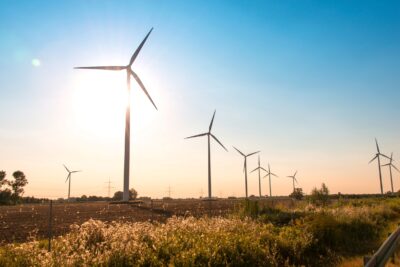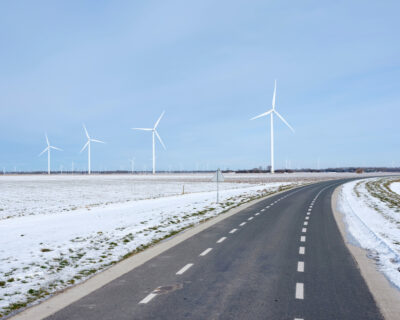Wind Turbines were not to blame for the recent blackouts in Texas. However, they were among the first to be accused when icy winds invaded and froze power production stations in Texas and other southern states.
Natural Gas Lines and Wind Turbines Froze, Coal Mines and Nuclear Plant Closed

Bright Summer Day: No Problem For Texas Wind Power.
Everything went wrong at once. Millions of Texans awoke on February 16 and discovered they had no power. NBC reported the story, while the storm spat ice, snow, and record low freezing temperatures. It was like the return of the “Ice Age.”
“This is the winter version of Hurricane Harvey,” Texas Gov. Greg Abbott told Houston ABC station KTRK.” Record energy demands were more than the state’s production could maintain.
Energy Failure: Should Florida Be Concerned?
Consolidated Waste Systems is deeply concerned with the power crisis in Texas and all the storm-affected states. Why are we worried? Here in Florida, our low temperatures normally range in the ’70s. So, why should we worry? Check Florida weather history. you’ll find the record low temperature recorded was in Tallahassee station on Feb. 13, 1899. It was -2 degrees, the only sub-zero day ever recorded in Florida.
Consequently, we know that what happened in Texas could happen here again. However, that’s only one of the reasons we are vitally concerned. We are also concerned because:
- First and foremost, we sympathize with the suffering of people in the freezing disaster areas.
- Secondly, we believe that renewable energy is vital to our future. It’s vital because we know that one-day our dirty fossil fuels will be depleted. Some scientists predict that could happen within 100 years.
- Additionally, natural sources of clean energy, such as wind, solar, and hydropower, don’t impact a healthy world.
- We at Consolidated Waste Systems also admit to a personal interest in Wind Turbines. Ultimately, it is up to companies like ours to dispose of the huge blades at the end of their life cycle.
So, for all the above reasons, these questions are important to understand. what happened? What went wrong? And who do we blame? So, please read on. Discover what we investigated.
The Ice Age Storm in Texas: What Happened?

Snow and Ice Are No Problem If Wind Powered Turbines Are Properly Winterized.
The deadly winter storm in Texas blacked-out almost 4 1/2 million people. Record-breaking low temperatures, make survival the big issue. As power failed, so did other survival supplies:
- Low Temperatures forced Water treatment plants to close. Then, water pipes froze and broke.
- Food stores closed as a result of the cold. In fact, desperate shoppers stripped food shelves before they closed.
- Heating systems were totally useless without power. Individuals lucky enough to have a fireplace struggled to find wood. One lady burned her framed art paintings and her child’s small wooden toys to keep her children warm.
- Texans, used to a warmer climate, were totally unprepared for the severe cold.
The struggle was more than enough disaster to cause both citizens and government to find blame. And find the blame they did.
Human Nature, Wind Turbines, and Blame-to-Go-Around
One of the very few things you can almost always predict and depend-on is human nature. When a disaster occurs, there is always more than enough blame to go around.
Sometimes, we blame ourselves and sometimes others. Here are just a few of the scapegoats that Texans and others blamed for the “Grid Failure.”
Energy: 3 First To Be Blamed
Three of the main accused included Wind Turbine electricity production, Natural gas producers, and the Electric Reliability Council of Texas (ERCOT).
Natural Gas And Wind Power Freeze Up When The Going Gets Tough

The Texas Turbines Were Totally Unprepared for the Great February Storm of 2021.
Forbes summed up charges against wind turbines and gas with the above headline and comments such as:
- Natural gas, coal, and wind turbines were frozen in the unusual cold snap and snow.
- Frozen gauge knocked out one of their four nuclear reactors because of a cold-caused false reading.
- The major loss was from natural gas.
Wind performed poorly, but that was mostly expected in winter and bad weather.
Wind Turbines Not to Blame For Freezing Up
The assumption that Wind Turbines must freeze up just because they did in Texas is erroneous. Facts do reveal that Texas did not prepare the Wind Turbines for extreme cold weather operations. They were not winterized.
It’s true that turbine blades can freeze-up. And they do so for the same reason that aircraft propellers suffer the same fate. However, aircraft have a de-icing system that prevents freeze-up. Texas turbines do not, at least not yet.
Wind Turbines Can Function Efficiently in Cold Weather
Wind produces as much as 60% of the total electricity in Texas at certain times. However, it is assumed that wind turbines decline in performance in winter or colder weather. So, the grid operator typically assumes that the turbines will generate only about 19% to 43%.
Are you aware of the “Canadian Winterizing Kit? Some sources say that it could solve many cold-weather problems. However, the price of special weather kits is costly. Considering Texas temperatures plus the extensive cost means these heating features are typically not installed on turbines in Texas.
It seems safe to say that the winter production could significantly increase with the use of something like the “Canadian Winter Kit.” This kit is available and is in use by companies in Canada under the guidance of the Canadian Wind Energy Association (CanWEA). Additionally, Claims by Canadians include:
- “The cost of wind energy has fallen 69 percent since 2009.
- Wind Turbines can work in temperatures as low as -22 degrees F.
- Additionally, they claim it is “one of the lowest-cost generating technologies available today.”
Question: Is the price tag too high, considering the advantages?
Electric Reliability Council of Texas Under Fire
According to the Texas Tribune, the Electric Reliability Council of Texas (ERCOT) was faced with “sharp criticism from a massive failure of the state power system that left millions last week without light, heat, and water.
The Electric Reliability Council of Texas is the agency that controls and operates the state’s power grid. In other words, the council manages the flow of electric power to more than 26 million customers.
Looking into the history of this agency, there is one dark story that emerges.
- A similar event took place over ten years ago.
- Reporters said, “plunging temperatures forced rolling blackouts across Texas…” According to USA Today, after the storm in 2011, experts made winterization recommendations to prevent a recurrence. However, these recommendations were never enforced.
Since the more recent storm, “state lawmakers have called for investigations into the Electric Reliability Council.” “Texans demanded accountability for the disaster.”
Electric Reliability Council of Texas Resignations

The Texas Power Grid Failed at Several Levels Leaving Cities in the Dark and Cold.
the board’s chairman, vice chairman, three directors, and a board nominee of the (ERCOT) submitted resignations. All 6 live outside of Texas. Their resignations became effective Wednesday, according to a notice to the state Public Utility Commission.
Texas Winter Storm Take-Aways
As stated earlier, Wind Turbines were not at fault. The fault would appear to lie with their management. Clean energy advocates have reassured us that Wind Turbines in Texas will continue. ERCOT and the Public Utility Commission will make some revisions in their winterization policies.
Thank you for reading our blog. Please return to share more information about Wind Power in “Trashing Wind Turbine Blades.”


